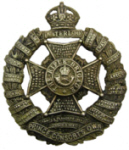




No.747, Rifleman, George FLACK
Aged 26

|
George Flack was born in West Wickham on 4th April 1888 (Linton Q2-1888 3B:525) son of Elijah and Elizabeth FLACK (née PRESTON).
1891 census...Aged 3, he was at The Street, West Wickham with his father Elijah FLACK [39] farm labourer; his mother Elizabeth [37]; brothers Frederick [18], Sidney [14] and Reuben [12] (all farm labourers), Christopher [10], Shadrack [8] and Albert [5 months]; sister Bessie [4]. All were born in West Wickham. 1901 census...Aged 12, he was at Streetly End, West Wickham with his parents; brothers Shadrack (farm labourer), Albert, Alexander [8], Walter [4] and Frank [3] (all born West Wickham); sister Elizabeth (Bessie). 1911 census...He seems most likely to be the George Flack with the 2nd Bttn. Rifle Brigade in India (Age given as 24, born Cambridge). His regimental number puts him as enlisting around 1905. At the Brickyard, West Wickham were his parents and brothers Albert, Aleck, Walter ( all farm labourers) and Frank (scholar). In 1913, having completed his term in the Army and being a farm labourer at Duxford, he married Emily FLACK ( a cousin) (Linton Q2-1913 3B:943). Born in Duxford on 28-5-1888, daughter of John and Sarah FLACK ( A West Wickham family). She is named as his sole legatee in "Soldiers Effects". Their son Arthur was born on 31-1-1914. In 1922 she married George's younger brother, Albert (Linton Q-3 1922 1319). On the pension card Emily was at New Cottages, St John's Street, Duxford. |

|
He enlisted in Haverhill, when resident in Cherryhinton, Cambridge. This would have been mobilisation as a Reservist. For some unknown reason his medal index card does not give the 1914 Star, which he was definitely awarded. It is possible there was another card recording the Star and clasp but it has not been found on line). The absence of the clasp to the 1914 Star can often be due to it not being claimed. Be that as it may, I have shown him as an Old Contemptible, he was hardly likely to have been killed in action if not within range of enemy guns ! On the 26th August the Battalion were in the retreat from Mons. The appendix to the Battalion war diary has :- Battle of August 26th Position of the battalion at daybreak on 26th: Battalion, less "C" Coy bivouacked on track on track leading NW from FONTAINE-AU-PIRE. "C" Coy on outposts at CATTENIERES About 5 a.m. the outposts saw German cavalry and artillery moving towards CATTENIERES. The Brigade was "standing to arms" and was ordered to retire and take up a position on the hill at CARRIERES, just SW of FONTAINE-AU-PIRE covered by the R.B. General direction of retirement was to be on HASUCOURT The battalion extended and lined the ridge just N of the track where they had bivouacked. The Germans opened their attack with artillery fire and except for a few cavalry near the village, no other hostile troops came into action at first. When the remainder of the Brigade and the baggage was clear, the Bn began to retire slowly, the left going back first and covering the retirement of the right companies. The retirement was carried out slowly and methodically under shell fire and rifle fire; the enemy sending troops onto the ridge vacated by our men as soon as they were clear. The Battalion closed in a sunken road running E and W across the hill at CARRIERES with I Coy on their left in the track running N and S across the hill. Here the Bn was at first in Reserve but owing to other troops being driven back from the N side of the hill, "C" Coy were sent forward to occupy the position and the Bn was in the firing line. The field of fire was very small and we could do nothing but lie still and be shelled most of the time. This was the position from about 8:20 am till about 2:45 pm with the S.L.I. who had retired, behind the railway and the HANTS and E.LANCS mostly in reserve just S of the bridge over the railway, but with about 2 Coys each more or less engaged in the firing line W of the track running N and S across the railway and hill. Very few German infantry showed themselves the they appeared unwilling to come on, but the hill was swept with a heavy fire from field guns and machine guns. About 2:25 pm the Brigade was ordered to retire on LIGNY; HANTS and E.LANCS first, followed by S.L.I. and R.B. "I" Coy were first of R.B. ordered back and retired down lane and across railway. By this time the HANTS and E.LANCS had started up the hill towards LIGNY and the Germans, realising what was happening, redoubled their fire. The other 3 Coys then retired more or less at the same time and suffered heavily from shell and rifle fire, enfilade fire from the direction of FONTAINE-AU-PIRE being especially troublesome. The church at LIGNY was given as a rendezvous and shortly after arrival there the enemy were reported in the NE end of the village. The Battalion was now split up, the majority, under Lieut Col Biddulph marched via CAULEERY and took up position at SELVIGNY afterwards moving via MALINCOURT - LE CATELET where there was a log halt -VENDHUILLE - TEMPLEUX- HERBECOURT arriving there about 10 am 27th. Meanwhile Capts Myent, Prittie and Brownlow had collected about 100 men at the church at LIGNY and starting out met the B.G.C with about 700 men belonging to other regiments of the Brigade. They marched SW but getting blocked by 3rd Div, turned and spent the night at SELVIGNY" CWGC puts the killed of the 1st battalion, Rifle Brigade on the 26th at 30, only 8 have known graves.
photo: Commonwealth War Graves Commission click here to go to the Commonwealth War Graves Commission website for full cemetery/memorial details |